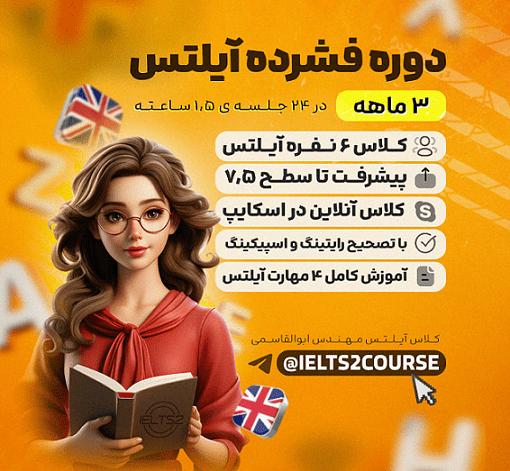آموزش لغات آیلتس برای موضوع مجسمه سازی
IELTS Vocabulary for Sculpture
لغات آیلتس درباره موضوع مجسمه سازی به همراه ترجمه فارسی و جمله هایی برای آن ها در این آموزش بررسی خواهند شد. مجسمه سازی یکی از قدیمیترین و تاثیرگذارترین هنرها در تاریخ بشر است که همواره با فرهنگها و تمدنهای مختلف ارتباط داشته است. این هنر میتواند موضوع جالب و چالشبرانگیزی در آزمون آیلتس، بهویژه در بخشهای اسپیکینگ و رایتینگ، باشد. در این مقاله، ما به بررسی واژگان کلیدی مرتبط با موضوع مجسمه سازی، نکات کاربردی و روشهایی برای استفاده بهینه از این لغات در آزمون آیلتس خواهیم پرداخت. همچنین، نمونههایی از سوالات پرتکرار اسپیکینگ و یک نمونه رایتینگ تسک 2 ارائه خواهد شد. دانلود کتاب های گلچین لغات موضوعی آیلتس pdf پیشنهاد بعدی ما به شما عزیزان است.
کلمات و لغات آیلتس درباره موضوع مجسمه سازی (Sculpture)
مجسمه سازی به عنوان یکی از هنرهای تجسمی، تأثیر زیادی بر فرهنگ و تاریخ بشر داشته است. از مجسمههای باستانی یونان و روم تا آثار مدرن، این هنر به انتقال ایدهها و احساسات کمک کرده است. امروزه مجسمه سازی در اشکال مختلفی مانند مجسمههای کوچک، آثار عمومی بزرگ و حتی هنر مفهومی دیده میشود. توانایی صحبت درباره این هنر با استفاده از واژگان مناسب میتواند به شما در آزمون آیلتس کمک کند تا پاسخهای دقیقتر و جذابتری ارائه دهید. لغات آیلتس موضوع مجسمه سازی را با هم میبینیم.
واژگان کلیدی آیلتس برای موضوع مجسمه سازی
1. Sculpture (مجسمه)
تعریف: یک اثر هنری که بهوسیله حکاکی یا شکلدهی به مواد مختلف مانند سنگ، فلز، چوب یا خاک رس ایجاد میشود.
مثال: “The sculpture in the city square was crafted by a famous artist.”
2. Sculptor (مجسمهساز)
تعریف: فردی که مجسمهها را میسازد یا طراحی میکند.
مثال: “Michelangelo is one of the most renowned sculptors in history.”
3. Carving (حکاکی)
تعریف: فرآیند ایجاد اشکال و نقوش در مواد سخت مانند چوب یا سنگ با استفاده از ابزارهای مختلف.
مثال: “The intricate carving on the marble statue was breathtaking.”
4. Clay (خاک رس)
تعریف: مادهای نرم که بهراحتی شکل میگیرد و معمولاً برای ساخت مجسمههای اولیه استفاده میشود.
مثال: “The sculptor used clay to form the initial shape of the figure.”
5. Bronze (برنز)
تعریف: نوعی فلز که اغلب در مجسمه سازی برای ایجاد آثار مقاوم و بادوام استفاده میشود.
مثال: “The bronze statue has stood in the park for over a century.”
6. Chisel (اسکنه)
تعریف: ابزاری با تیغه تیز که برای حکاکی و برش دادن مواد سخت مانند سنگ یا چوب استفاده میشود.
مثال: “The sculptor used a chisel to carve the details of the sculpture.”
7. Casting (ریختهگری)
تعریف: فرآیندی که در آن ماده مایع، معمولاً فلز، به داخل قالب ریخته میشود تا شکل دلخواه ایجاد شود.
مثال: “Casting is a common technique in bronze sculpture.”
8. Abstract (انتزاعی)
تعریف: نوعی از هنر که فرمها و اشکال را بهطور غیرواقعی و مفهومی نشان میدهد.
مثال: “The abstract sculpture in the gallery sparked a lot of debate among the visitors.”
9. Installation (نصب)
تعریف: مجموعهای از آثار هنری که معمولاً در محیطهای عمومی نصب میشوند و بخشی از فضای خاصی را تشکیل میدهند.
مثال: “The installation sculpture in the park has become a landmark.”
10. Proportion (تناسب)
تعریف: رابطه بین اندازهها و ابعاد مختلف یک مجسمه یا اثر هنری.
مثال: “The sculptor paid close attention to the proportions of the human figure.”
11. Texture (بافت)
تعریف: سطح خارجی یک مجسمه و نحوه حس شدن آن هنگام لمس، مثلاً صاف، خشن یا زبر.
مثال: “The texture of the stone sculpture was rough, adding to its natural appearance.”
12. Monument (یادبود)
تعریف: یک مجسمه یا ساختار بزرگ که به منظور یادبود یک شخص، رویداد یا ایده ساخته میشود.
مثال: “The monument in the city square commemorates the soldiers who fought in the war.”
13. Studio (کارگاه)
تعریف: مکانی که در آن مجسمهسازان و هنرمندان دیگر برای خلق آثار هنری کار میکنند.
مثال: “The artist spent months working on the sculpture in her studio.”
14. Foundry (کارخانه ریختهگری)
تعریف: مکانی که در آن فلزات ذوب و ریختهگری میشوند تا مجسمهها و آثار فلزی دیگر ساخته شوند.
مثال: “The bronze statue was created in a local foundry.”
15. Relief (نقش برجسته)
تعریف: نوعی مجسمه که در آن تصاویر و اشکال بهصورت برجسته از سطح پسزمینه ایجاد میشوند.
مثال: “The relief sculpture on the temple walls depicted scenes from ancient mythology.”
نکات کاربردی برای استفاده از واژگان موضوع مجسمه سازی در آزمون آیلتس
استفاده از این واژگان در پاسخهای اسپیکینگ و رایتینگ آیلتس میتواند به شما کمک کند تا توصیفهای دقیقتر و حرفهایتری ارائه دهید. برای بهبود مهارتهای خود، سعی کنید این لغات را در جملات روزمره و در تمرینات خود به کار ببرید. همچنین، میتوانید با مطالعه مقالات و منابع مرتبط با هنر، از نحوه استفاده صحیح این واژگان آگاهی بیشتری پیدا کنید. لغات آیلتس موضوع مجسمه سازی را به خوبی میتوانید در نمونه سوالات اسپیکینگ و رایتینگ زیر درباره همین تاپیک ببینید.
سوالات پرتکرار اسپیکینگ آیلتس برای موضوع مجسمه سازی
- What do you think about public sculptures?
- جواب: “I believe public sculptures play an important role in enhancing the aesthetic appeal of a city. They not only serve as landmarks but also reflect the cultural and historical significance of the location.”
- Have you ever visited a museum with sculptures?
- جواب: “Yes, I recently visited an art museum that had a collection of classical sculptures from the Renaissance period. The craftsmanship and attention to detail were truly impressive.”
- Do you think sculpture is an important art form?
- جواب: “Absolutely. Sculpture is a timeless art form that allows artists to express themselves in three dimensions. It has the ability to evoke strong emotions and engage viewers in a unique way.”
- Would you like to learn how to create sculptures?
- جواب: “Yes, I would love to learn sculpture. I think it would be incredibly rewarding to shape raw materials into meaningful forms and explore my creativity through a different medium.”
نمونه رایتینگ تسک 2 آیلتس برای تاپیک مجسمه سازی
Some people believe that public art, such as sculptures, should be funded by the government, while others argue that it is a waste of money. Discuss both views and give your opinion.
Public art, including sculptures, has long been a subject of debate. While some people believe that government funding for public art is essential to promote culture and beautify cities, others argue that it is an unnecessary expense. In this essay, I will discuss both perspectives and provide my own opinion on the matter.
On the one hand, supporters of government-funded public art believe that it plays a crucial role in shaping the cultural identity of a community. Sculptures and other forms of public art serve as a reminder of a region’s history, values, and creativity. For example, iconic sculptures like the Statue of Liberty in the United States or the Christ the Redeemer statue in Brazil are not only symbols of national pride but also attract millions of tourists every year. Additionally, public art can enhance the aesthetic appeal of cities, making them more attractive places to live and visit.
On the other hand, critics argue that government resources should be allocated to more pressing issues, such as healthcare, education, and infrastructure. They believe that public art is a luxury that should not take precedence over essential services. Moreover, some people feel that art is a subjective matter, and not everyone may appreciate or benefit from sculptures and other artworks displayed in public spaces. As a result, they suggest that public art should be funded by private sponsors or philanthropic organizations instead of taxpayers’ money.
In my opinion, while it is important to address critical societal needs, public art should not be neglected. It contributes to the cultural enrichment of communities and helps create a sense of belonging. Furthermore, investing in public art can have long-term economic benefits by boosting tourism and local businesses. Therefore, I believe that a balanced approach is necessary, where public art receives sufficient funding without compromising
where public art receives sufficient funding without compromising essential public services. By allocating a portion of the budget to support public art, governments can ensure that cities remain culturally vibrant and appealing while also addressing the basic needs of their citizens. Additionally, collaborations between public and private sectors can be encouraged, allowing for both financial support from private donors and oversight from public institutions.
In conclusion, while some may argue that funding public art, such as sculptures, is a waste of money, I believe that it is an important investment in the cultural and aesthetic development of communities. Public art not only enhances the visual appeal of cities but also contributes to a sense of identity and pride. Therefore, governments should continue to support public art while balancing the need to address other critical issues.
نتیجه گیری
چندین مورد از لغات آیلتس موضوع مجسمه سازی همراه با مثال هایی برای پرتکرار ترین تاپیک های رایتینگ و اسپیکینگ آیلتس را با هم در این صفحه بررسی کردیم. این آموزش از یکی از سایت های آموزشی مرجع آیلتس را در همین زمینه به شما عزیزان پیشنهاد میکنیم. ضمنا هر سوالی برای شما مطرح هست با در بخش کامنت ها در همین صفحه یا در گروه آموزش رایگان آیلتس ما در تلگرام حتما مطرح بفرمایید ❤️







